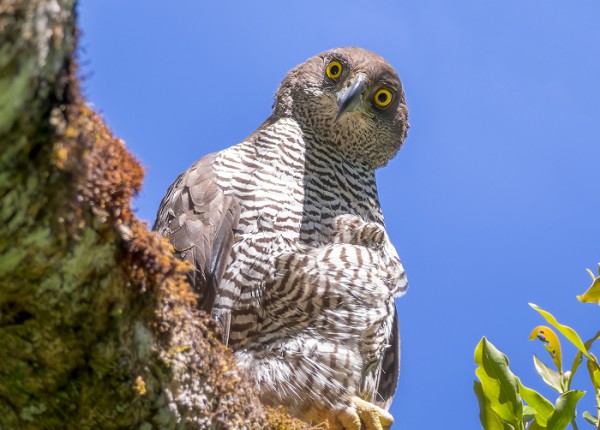Did you know:
- Henst’s Goshawks are usually heard before they are seen—they have a high-pitched, piercing call that is regularly used during breeding season.
- They create large nests among large-forked branches in mature and tall trees.
How The Peregrine Fund is Helping
The Peregrine Fund has been working for many years to protect and study the Henst’s Goshawk. Today, our Madagascar Program studies endangered and poorly known Malagasy raptors, develops local and national capacity in biodiversity conservation, and increases the size of Madagascar's Protected Areas System. The program currently manages four Protected Areas, including a 75,000 ha (300 sq. mi.) rainforest corridor and three Ramsar wetland sites that equal 114,000 ha (450 sq. mi.). These Protected Areas provide important habitat to countless Madagascar raptor species, including the Henst’s Goshawk.
Where They Live
The Henst’s Goshawk is endemic to Madagascar. It makes its home throughout the primary rainforests in the east and dry forests of the west. It can sometimes be found in secondary woodland and has been recorded in Eucalyptus plantations.
What They Do
The Henst’s Goshawk is mostly brownish-gray on its body with a finely barred brown and white chest and belly. They have a distinctive pale stripe above their yellow eyes, a black bill, and yellow-green legs. They are known by locals for their loud, high-pitched call, especially during breeding season. Henst’s Goshawks are notoriously aggressive during breeding season, defending their nests from competitors and predators.
Why They Need our Help
Only found in Madagascar at low densities with a large home range size, the Henst’s Goshawk is particularly vulnerable to population declines. It is classified by the IUCN only as Vulnerable—meaning populations could be in danger from ongoing and future threats. The most prominent threat to their populations is deforestation via slash and burn or logging (to create agricultural fields or for the sale of timber).
What They Eat
Henst’s Goshawks are impressive, powerful hunters, with the majority of their diet composed of medium birds and mammals. They can be seen taking down large forest birds like Helmeted Guineafowl and Blue Couas, as well as mammals including lemurs and tenrecs. It hunts below the canopy, using the cover of the trees to hide and wait for prey to appear below.
Nests, Eggs and Young
Pairs start claiming territories in July with egg laying commencing in September–October. Henst’s Goshawks build large stick nests, over 3 ft (1 m) in diameter, high up in the main fork of mature, tall trees. Pairs sometimes reuse nests from the previous year instead of building a new one from scratch. Females lay 2–3 white eggs and do the majority of incubating until the eggs are ready to hatch around 40 days after laying. The female continues to do the majority of the brooding, keeping the nestlings warm while the male spends most of his time hunting and bringing food back to the nest. On the Masoala Peninsula, our team documented a total of 1.14 young fledging per nest and 57% reproductive success. The nestlings take around 45 days to reach fledging age, at which point they leave the nest, but remain close to the nest site until 70 days old. They do not become fully independent until 90 days.
Resources:
Kemp, A. C., D. A. Christie, and G. M. Kirwan (2024). Henst's Goshawk (Astur henstii), version 1.1. In Birds of the World (J. del Hoyo, A. Elliott, J. Sargatal, D. A. Christie, and E. de Juana, Editors). Cornell Lab of Ornithology, Ithaca, NY, USA. https://doi.org/10.2173/bow.hengos1.01.1
BirdLife International (2020). Species factsheet: Henst's Goshawk Accipiter henstii. Downloaded from https://datazone.birdlife.org/species/factsheet/hensts-goshawk-accipiter-henstii on 02/05/2025
Rene de Roland L-A. 2000. Breeding biology of Henst's Goshawk Accipiter henstii on Masoala Peninsula, northeastern Madagascar. In Chancellor, R.D. & B-U, Meyburg. Raptors at Risk. WWGBP/Hancock House.









